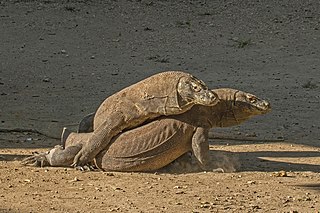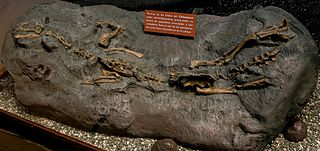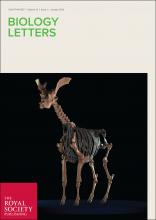
Dinosaurs are a diverse group of reptiles of the clade Dinosauria. They first appeared during the Triassic period, between 245 and 233.23 million years ago (mya), although the exact origin and timing of the evolution of dinosaurs is a subject of active research. They became the dominant terrestrial vertebrates after the Triassic–Jurassic extinction event 201.3 mya and their dominance continued throughout the Jurassic and Cretaceous periods. The fossil record shows that birds are feathered dinosaurs, having evolved from earlier theropods during the Late Jurassic epoch, and are the only dinosaur lineage known to have survived the Cretaceous–Paleogene extinction event approximately 66 mya. Dinosaurs can therefore be divided into avian dinosaurs—birds—and the extinct non-avian dinosaurs, which are all dinosaurs other than birds.

An anapsid is an amniote whose skull lacks one or more skull openings near the temples. Traditionally, the Anapsida are the most primitive subclass of amniotes, the ancestral stock from which Synapsida and Diapsida evolved, making anapsids paraphyletic. It is however doubtful that all anapsids lack temporal fenestra as a primitive trait, and that all the groups traditionally seen as anapsids truly lacked fenestra.

The Varanidae are a family of lizards in the superfamily Varanoidea and order Anguimorpha. The family, a group of carnivorous and frugivorous lizards, includes the living genus Varanus and a number of extinct genera more closely related to Varanus than to the earless monitor lizard (Lanthanotus). Varanus includes the Komodo dragon, crocodile monitor, savannah monitor, the goannas of Australia and Southeast Asia, and various other species with a similarly distinctive appearance. Their closest living relatives are the earless monitor lizard and chinese crocodile lizard. The oldest members of the family are known from the Late Cretaceous of Mongolia.

Rhynchocephalia is an order of lizard-like reptiles that includes only one living species, the tuatara of New Zealand. Despite its current lack of diversity, during the Mesozoic rhynchocephalians were a diverse group including a wide array of ecologies. The oldest record of the group is dated to the Middle Triassic around 238 to 240 million years ago, and they had achieved a worldwide distribution by the Early Jurassic. Most rhynchocephalians belong to the group Sphenodontia ('wedge-teeth'). Their closest living relatives are lizards and snakes in the order Squamata, with the two orders being grouped together in the superorder Lepidosauria.
Proceedings of the Royal Society is the main research journal of the Royal Society. The journal began in 1831 and was split into two series in 1905:

Blackawton is a village and civil parish in the South Hams district of Devon, England. According to the 2001 census, it had a population of 647. Blackawton is a major part of the West Dart electoral ward. The ward's population at the 2011 census was 1,946. The village is about six miles west of Dartmouth.

Michael James Benton is a British palaeontologist, and professor of vertebrate palaeontology in the School of Earth Sciences at the University of Bristol. His published work has mostly concentrated on the evolution of Triassic reptiles but he has also worked on extinction events and faunal changes in the fossil record.

The evolution of birds began in the Jurassic Period, with the earliest birds derived from a clade of theropod dinosaurs named Paraves. Birds are categorized as a biological class, Aves. For more than a century, the small theropod dinosaur Archaeopteryx lithographica from the Late Jurassic period was considered to have been the earliest bird. Modern phylogenies place birds in the dinosaur clade Theropoda. According to the current consensus, Aves and a sister group, the order Crocodilia, together are the sole living members of an unranked reptile clade, the Archosauria. Four distinct lineages of bird survived the Cretaceous–Paleogene extinction event 66 million years ago, giving rise to ostriches and relatives (Palaeognathae), ducks and relatives (Anseriformes), ground-living fowl (Galliformes), and "modern birds" (Neoaves).

Saurischia is one of the two basic divisions of dinosaurs, classified by their hip structure. Saurischia and Ornithischia were originally called orders by Harry Seeley in 1888 though today most paleontologists classify Saurischia as an unranked clade rather than an order.
Sterling Nesbitt is an American paleontologist best known for his work on the origin and early evolutionary patterns of archosaurs. He is currently an associate professor at Virginia Tech in the Department of Geosciences.

Silesauridae is an extinct family of Triassic dinosauriforms. It is most commonly considered to be a clade of non-dinosaur dinosauriforms, and the sister group of dinosaurs. Some studies have instead suggested that most or all silesaurids comprised an early diverging clade or a paraphyletic grade within ornithischian dinosaurs. Silesaurids have a consistent general body plan, with a fairly long neck and legs and possibly quadrupedal habits, but most silesaurids are heavily fragmentary nonetheless. Furthermore, they occupied a variety of ecological niches, with early silesaurids being carnivorous and later taxa having adaptations for specialized herbivory. As indicated by the contents of referred coprolites, Silesaurus may have been insectivorous, feeding selectively on small beetles and other arthropods.
Gareth John Dyke is a paleontologist whose work is concerned with the evolutionary history of birds and their dinosaurian relatives. His specific research interests include the phylogenetics of birds, the functional morphology of aves and non-avian dinosaurs, as well as the paleoenvironments of fossil vertebrates.
The plate-toothed giant hutia is an extinct species of rodent in the family Heptaxodontidae. It is the only species within the genus Elasmodontomys. It was found in Puerto Rico.

David John Beerling is the Director of the Leverhulme Centre for Climate change mitigation and Sorby Professor of Natural Sciences in the Department of Animal and Plant Sciences (APS) at the University of Sheffield, UK. He is also Editor-in-Chief of the Royal Society journal Biology Letters.
Michael E. Hochberg is an American population biologist. He is currently a Research Director at the Centre National de la Recherche Scientifique, University of Montpellier, France, and a member of the External Faculty at the Santa Fe Institute.

Chilesaurus is an extinct genus of herbivorous dinosaur. The type and only known species so far is Chilesaurus diegosuarezi. Chilesaurus lived about 145 million years ago (Mya) in the Late Jurassic period of Chile. Showing a combination of traits from theropods, ornithischians, and sauropodomorphs, this genus has far-reaching implications for the evolution of dinosaurs, such as whether the traditional saurischian-ornithischian split is superior or inferior to the proposed group Ornithoscelida.
Kleptopredation is a form of feeding in which a predator eats prey after the prey has hunted, consuming both the prey and its recent meal. It is a specific type of kleptoparasitism. The term was first used in an article published in the journal Biology Letters.

Susannah "Susie" Catherine Rose Maidment is a British palaeontologist at the Natural History Museum, London. She is internationally recognised for her research on ornithischian dinosaur evolution, and was awarded the 2016 Hodson Award of the Palaeontological Association and the 2017 Lyell Fund of the Geological Society of London. She was featured as a 2019 National Geographic Women of Impact.
Maria Byrne is professor of marine and developmental biology at the University of Sydney and a member of the Sydney Environment Institute. She spent 12 years as director of the university's research station on One Tree Island.
Alice Auersperg is an Austrian cognitive biologist specializing in the evolution of intelligence in birds. Her research is primarily focused on the physical cognition, play behavior, problem-solving and tool-making abilities in parrots and corvids. Since 2011, she has managed the Goffin Lab of Comparative Cognition at the Messerli Research Institute of the University of Veterinary Medicine Vienna in Austria, where she has extensively studied the intelligence of the Tanimbar corella, also known as the Goffin's cockatoo.












